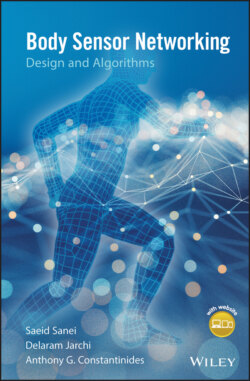Читать книгу Body Sensor Networking, Design and Algorithms - Saeid Sanei - Страница 13
1.3 BSN Architecture
ОглавлениеThe general architecture of a BSN is shown in Figure 1.1. Sensor nodes which are placed around and possibly inside the body collect physiological data and perform preliminary processing. The data are then gathered by a sink node and transmitted to a local PC or mobile system for personal or local use (such as alarming) or the base station of a public network to share with relevant bodies over the Internet. The recipient of the BSN data can be healthcare units, social welfare, emergency units within hospitals, or other experts in clinical, experimental, and sport departments. For any one of the above cases there are many design and technical challenges to tackle.
Figure 1.1 Overall architecture of a BSN.
A more detail architecture, which are discussed in the corresponding chapter of this book, involves various levels and modes of communications between the body-mounted sensors and the corresponding clinical or social agencies. Such data transfer systems inherently include in-house or short-range media (approximately 2–3 m), often called intra-BAN communication, between personal and public network (inter-BAN communication), and those entirely within public wireless communication system (beyond-BAN communication).
Figure 1.2 summarises the main research areas of BSNs. Some research has been in progress on how to design wearable sensors [38], fault diagnosis of the BSN and how to mitigate the faults and avoid their impacts [39], energy consumption and energy harvesting [40], and sensor deployment [41]. Without doubt, tremendous research in signal processing – particularly on denoising [42], artefact removal, feature detection, data decomposition, estimation, feature extraction [43], and data compression [44] – has been carried out intensively for various applications. Such valuable experiences can be directly exploited and integrated within the design of BSNs.
Data fusion, as another BSN direction of research, has been under vast development as new techniques in multimodal data recording, analysis, and multiagent distributed systems and networks have been introduced.
Moreover, machine learning techniques have powered up BSN research by developing new techniques in clustering, classification [45], anomaly detection, and decision making as well as many other approaches in big data analytics, to suit the corresponding data.
Figure 1.2 Main research areas in a BSN.
BSNs have been looked at through different angles by a growing number of scholars in sensor technology, data processing, and communications. Some researchers have combined situational awareness and data fusion technologies to enable human activity recognition [46, 47]. Others have tried to understand the data by developing sophisticated signal processing algorithms to deal with multichannel biomedical data [48, 49]. Indeed, the design and provision of supercomputers, availability of large memory clusters, and accessibility of the cloud have been crucial to the expansion of sensor networks. Moreover, new data processing and machine learning methods based on tensor factorisation, cooperative learning, graph theory, kernel-based classification, deep learning neural networks, and distributed systems together with pervasive computing have revolutionised the assessment of the information collected from multisensor networks, particularly when the dataset is large. Network communication, on the other hand, involves network topology design [50], channel characterization [51], channel access control [52, 53], routing algorithm design [54], lightweight communication protocols design, energy harvesting in a network, and many other issues related to short- and long-range communications. These key technologies must be considered and further developed for building a complete BSN system.
To enable long-term data collection from the human body, biocompatible sensors and devices need to be designed. This field of research brings new areas of engineering researchers in biotechnology, biomaterials, bioelectronics, and biomechanics together to develop practical sensors.
The demand for a green environment pushes for the optimization of energy harvesting and an effective solution to energy consumption together with enhancing the QoS. For WSNs the plethora of battery technologies available today enables system designers to tailor their energy storage devices to the needs of their applications. The latest lithium battery technologies allow optimization for any operating lifetime or environment. For applications with small temperature variation and short lifetime, lithium manganese dioxide (LiMnO2) batteries provide solid performance at cost-effective prices, while applications demanding large temperature ranges and multidecade lifetimes are satisfied with batteries based on lithium thionyl chloride (LiSOCL2) chemistry [7].
While batteries represent the preferred low-cost energy storage technology, energy harvesting/scavenging devices are beginning to emerge as viable battery replacements in some applications. For example, power can be generated from temperature differences through thermoelectric and pyroelectric effects, kinetic motion of piezoelectric materials, photovoltaic cells that capture sunlight, or even the direct conversion of RF (radio frequency) energy through specialised antennas and rectification. Examples of energy scavenging/harvesting devices coming to market today include piezoelectric light, solar batteries, and doorbell switches. Although the above technology can solve BSN problems, further research is needed for designing biologically powered systems and biocompatible batteries which can last longer while being attached to body internal tissues.
Finally, secure connections and data security are vital, particularly when personal information is analysed or communicated. In parallel with increasing complexity in data hacking algorithms, there is great demand for producing more sophisticated data encryption and network security.
In dealing with BSNs, machine-centric and human-centric challenges confront researchers. The machine-centric problems, as mentioned before, include security [55], compatibility or interoperability; sensor design and sensor validity; data consistency, as the data residing on multiple mobile devices and wireless patient notes need to be collected and analysed in a seamless fashion; interference; and data management [56, 57].
Besides hardware-centric challenges, human-centric challenges include cost, constant monitoring, deployment constraints, and performance limitations [13, 58–61], which need to be taken care of in any BSN design. After all, the wearable system should be acceptable, convenient, and user friendly.
